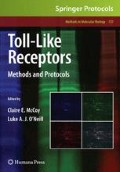Summary
Forward genetics has led to many discoveries and particularly in the field of Toll-like receptors (TLRs), it has played an important role in identifying key components involved in the innate sensing of pathogens. With the mouse genome fully sequenced and the ability to generate many mutant phenotypes through random germline mutagenesis, forward genetics has become an efficient means by which to identify key components involved in our immune response. In this chapter I provide a practical guide for performing germline mutagenesis in mice. I focus on the application of this technology to the identification of genes involved in TLR signaling.
Access this chapter
Tax calculation will be finalised at checkout
Purchases are for personal use only
References
Brunkow, M. E., Jeffery, E. W., Hjerrild, K. A., Paeper, B., Clark, L. B., Yasayko, S. A., Wilkinson, J. E., Galas, D., Ziegler, S. F., and Ramsdell, F. (2001) Disruption of a new forkhead/winged-helix protein, scurfin, results in the fatal lymphoproliferative disorder of the scurfy mouse. Nat. Genet. 27, 68–73.
Lee, S. H., Webb, J. R., and Vidal, S. M. (2002) Innate immunity to cytomegalovirus: the Cmv1 locus and its role in natural killer cell function. Microbes. Infect. 4, 1491–1503.
Scalzo, A. A., Wheat, R., Dubbelde, C., Stone, L., Clark, P., Du, Y., Dong, N., Stoll, J., Yokoyama, W. M., and Brown, M. G. (2003) Molecular genetic characterization of the distal NKC recombination hotspot and putative murine CMV resistance control locus. Immunogenetics 55, 370–378.
Webb, J. R., Lee, S. H., and Vidal, S. M. (2002) Genetic control of innate immune responses against cytomegalovirus: MCMV meets its match. Genes Immun. 3, 250–262.
Poltorak, A., He, X., Smirnova, I., Liu, M. Y., Van Huffel, C., Du, X., Birdwell, D., Alejos, E., Silva, M., Galanos, C., Freudenberg, M., Ricciardi-Castagnoli, P., Layton, B., and Beutler, B. (1998) Defective LPS signaling in C3H/HeJ and C57BL/10ScCr mice: mutations in Tlr4 gene. Science 282, 2085–2088.
Hoebe, K., Georgel, P., Rutschmann, S., Du, X., Mudd, S., Crozat, K., Sovath, S., Shamel, L., Hartung, T., Zahringer, U., and Beutler, B. (2005) CD36 is a sensor of diacylglycerides. Nature 433, 523–527.
Balling, R. (2001) ENU mutagenesis: analyzing gene function in mice. Annu. Rev. Genomics Hum. Genet. 2, 463–492.
Favor, J., Neuhauser-Klaus, A., and Ehling, U. H. (1998) The effect of dose fractionation on the frequency of ethylnitrosourea-induced dominant cataract and recessive specific locus mutations in germ cells of the mouse. Mutat. Res. 198, 269–275.
Favor, J., Neuhauser-Klaus, A., Ehling, U. H., Wulff, A., and van Zeeland, A. A. (1997) The effect of the interval between dose applications on the observed specific-locus mutation rate in the mouse following fractionated treatments of spermatogonia with ethylnitrosourea. Mutat. Res. 374, 193–199.
Rinchik, E. M., Carpenter, D. A., and Selby, P. B. (1990) A strategy for fine-structure functional analysis of a 6- to 11-centimorgan region of mouse chromosome 7 by high-efficiency mutagenesis. Proc. Natl. Acad. Sci. U. S. A. 87, 896–900.
Rinchik, E. M. and Carpenter, D. A. (1999) N-ethyl-N-nitrosourea mutagenesis of a 6- to 11-cM subregion of the Fah-Hbb interval of mouse chromosome 7: Completed testing of 4557 gametes and deletion mapping and complementation analysis of 31 mutations. Genetics 152, 373–383.
Russell, W. L., Hunsicker, P. R., Carpenter, D. A., Cornett, C. V., and Guinn, G. M. (1982) Effect of dose fractionation on the ethylnitrosourea induction of specific-locus mutations in mouse spermatogonia. Proc. Natl. Acad. Sci. U. S. A. 79, 3592–3593.
Russell, W. L., Hunsicker, P. R., Raymer, G. D., Steele, M. H., Stelzner, K. F., and Thompson, H. M. (1982) Dose–response curve for ethylnitrosourea-induced specific-locus mutations in mouse spermatogonia. Proc. Natl. Acad. Sci. U. S. A. 79, 3589–3591.
Justice, M. J., Noveroske, J. K., Weber, J. S., Zheng, B., and Bradley, A. (1999) Mouse ENU mutagenesis. Hum. Mol. Genet. 8, 1955–1963.
Concepcion, D., Seburn, K. L., Wen, G., Frankel, W. N., and Hamilton, B. A. (2004) Mutation rate and predicted phenotypic target sizes in ethylnitrosourea-treated mice. Genetics 168, 953–959.
Hoebe, K., Du, X., Goode, J., Mann, N., and Beutler, B. (2003) Lps2: a new locus required for responses to lipopolysaccharide, revealed by germline mutagenesis and phenotypic screening. J. Endotoxin. Res. 9, 250–255.
Author information
Authors and Affiliations
Corresponding author
Editor information
Editors and Affiliations
Rights and permissions
Copyright information
© 2009 Humana Press, a part of Springer Science + Business Media, LLC
About this protocol
Cite this protocol
Hoebe, K. (2009). Genetic Dissection of Toll-Like Receptor Signaling Using ENU Mutagenesis. In: McCoy, C.E., O’Neill, L.A.J. (eds) Toll-Like Receptors. Methods in Molecular Biology™, vol 517. Humana Press, Totowa, NJ. https://doi.org/10.1007/978-1-59745-541-1_15
Download citation
DOI: https://doi.org/10.1007/978-1-59745-541-1_15
Publisher Name: Humana Press, Totowa, NJ
Print ISBN: 978-1-934115-72-5
Online ISBN: 978-1-59745-541-1
eBook Packages: Springer Protocols

